The Traces We Leave
Rice at the Heart of High Energy Collaboration
The universe remembers where it came from, holding its memories in ripples of radiation, in the trajectories of particles, in the way matter still clumps and flows through space. And science, despite the claims of objectivity and detachment, is no different. It remembers, too — in the methods we inherit, in the units we standardize, in the names that become a part of the language we use without even noticing.
The story of Rice physics is, in truth, a microcosm of a much larger story — a story of not just experiments, but of the people who built them. It is the story of human progress and development, of students becoming mentors, of ideas reshaped across generations, of a culture that treats discovery and legacy as messages meant to be carried forward.
Over the past 30 years, Rice has helped lead two of the most ambitious scientific collaborations ever undertaken: the Compact Muon Solenoid (CMS) at CERN, where thousands of scientists work together to study the forces and particles that underpin the universe, and the Solenoidal Tracker at RHIC (STAR) at Brookhaven National Laboratory, where researchers recreate the same matter that existed in the universe’s first few millionths of a second. These experiments investigate different epochs of cosmic history, but Rice’s role in each is guided by the same principle: that scientific progress isn’t born from isolated moments or individuals, but from what happens in between — between the time of discovery and mentorship, of research and teaching, of the asking of a question and its answer.
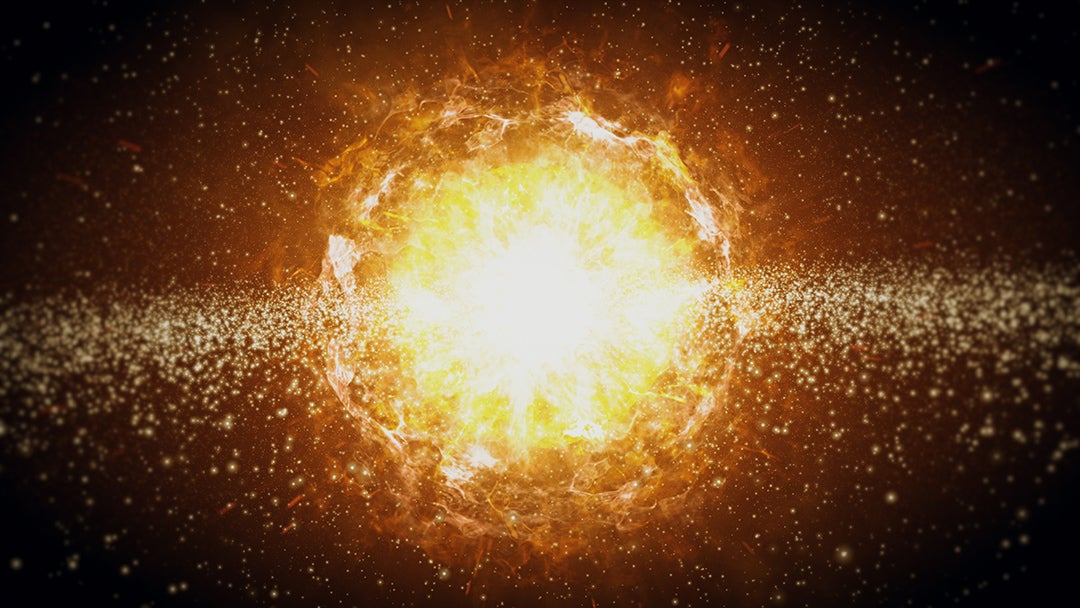
The Cosmic Timeline
According to our best understanding of the cosmos, the universe began 13.8 billion years ago in a flash of unimaginable energy. In less than one trillionth of a trillionth of a second, space itself expanded faster than the speed of light, and a moment now known as cosmic inflation fundamentally reshaped the universe’s structure. Within the first microseconds, as the universe cooled, energy began to settle into matter, and what had been a seething sea of particles began to take on form.
Those early transformations are long past, but their traces — carried in radiation, in matter and in the forces that govern the universe — remain measurable even today. Scientists have spent decades learning how to recreate the conditions where those traces first appeared, building experiments to search for the birth of mass or to capture fleeting glimpses of matter at the threshold of formation. At Rice, physicists have worked across this timeline, helping design critical elements of CMS and STAR, two of the experiments that have made groundbreaking achievements in their respective fields.
Rice at CMS: Decoding the Collider

At CERN, a particle accelerator complex located near Geneva, Switzerland, scientists working on the CMS experiment are part of one of the largest scientific collaborations in history. With more than 5,000 scientists from over 200 institutions, CMS is a global effort to understand what the universe is made of, how its smallest constituents behave and what hidden forces might still be at play. Rice became an early member of the collaboration in the mid-1990s, well before the detector was complete — a decision catalyzed by Professor Paul Padley, who established Rice’s focus toward CERN following the cancellation of the Texas-based Superconducting Super Collider.
From the beginning, Rice’s work centered on helping CMS make sense of chaos. Inside the Large Hadron Collider (LHC), protons are accelerated to near light speed and smashed together, recreating conditions that occurred just after the Big Bang. CMS, one of the detectors positioned around these collision points, is essentially a giant, layered camera that captures the paths, energies and decay patterns of the particles produced. Each collision can briefly create rare, short-lived signals — but CMS records more than one billion of these events per second. The scale of this is nearly incomprehensible: Billions of collisions produce more than 100 terabytes of data every second. “And you have to throw most of it out,” Padley explained. “You can’t possibly keep that much data.”
So how do we sort through such a massive dataset? Rice physicists have worked the past three decades on this problem, helping to design the custom electronics to make this task possible. Led by Padley and lead engineer Mike Matveev, Rice physicists helped develop muon port cards — programmable electronics that decide, in real time, which collisions are worth keeping. These cards are part of CMS’s trigger system, a set of layered decision-making tools that identify interesting patterns in the data and discard the rest.
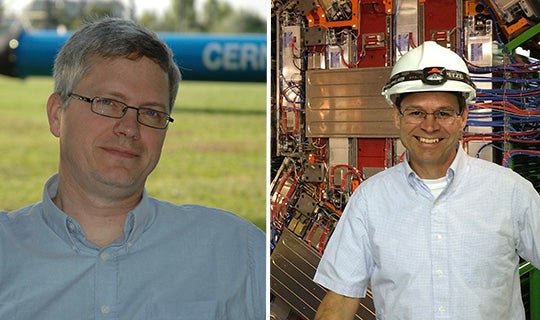
Professor Karl Ecklund helped lead development of the pixel detector, a high-resolution tracking system that records the paths of particles immediately after a collision. Together with the endcap muon system, the name of the subsystem containing these parts, the pixel detectors are essential for identifying particles like muons, charged particles that pass cleanly through most materials and leave especially distinct signals.
Professor Darin Acosta designed the “track finding” electronics system for linking the muon detector data into trajectories in the CMS endcaps, allowing the momentum of muons to be calculated using machine-learning algorithms that were embedded into the electronics with the help of Rice engineer Patrick Kelling and Rice graduate students.
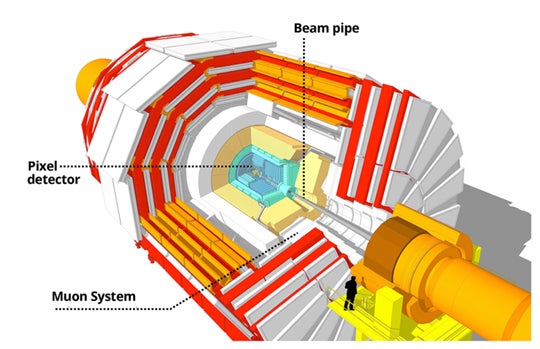
The pixel detector is closest to where the LHC beams collide and receives the “first” measurements of charged particles. The muon system’s detectors are the “last” ones a particle will encounter. These systems to detect muons aren’t just data pipelines — they’re essential for spotting the rare events the LHC was built for.
One of the most celebrated moments in CERN’s history came in 2012, with the discovery of the Higgs field — a field that fills all of space and, through a process called symmetry breaking, allows certain particles to gain mass. This discovery confirmed a missing piece of the Standard Model of particle physics, a model that describes all known fundamental particles in the universe, even more fundamental than the periodic table. Part of the most convincing evidence for the existence of the Higgs comes from its decay into leptons, a subgroup of fundamental particles that includes electrons and muons. Padley described these signatures as unmistakable: “There are other ways to detect the Higgs, but this is a very, very clean way.”
These clean signatures allowed scientists at CMS to further probe the Higgs after its initial discovery, yielding more accurate data on its properties. The same detector systems Rice helped build — from the pixel tracker to the muon system — were essential to that result. “If we hadn’t done the work on the muon system,” Padley said, “we would not have been able to find the Higgs.” The significance of this breakthrough is still being recognized today, as the CMS, ATLAS, ALICE and LHCb collaborations were jointly awarded the 2025 Breakthrough Prize in Fundamental Physics for their collective contributions to the LHC.
At Rice, building the hardware has never been the whole story. What has made Rice’s contributions unique, as Padley said, is that faculty and students alike have been deeply involved in both the technology and the physics. “To be a good experimental scientist, you have to be able to not just know how to analyze data, but how to actually build experiments,” he said. “That’s always been a feature at Rice.”
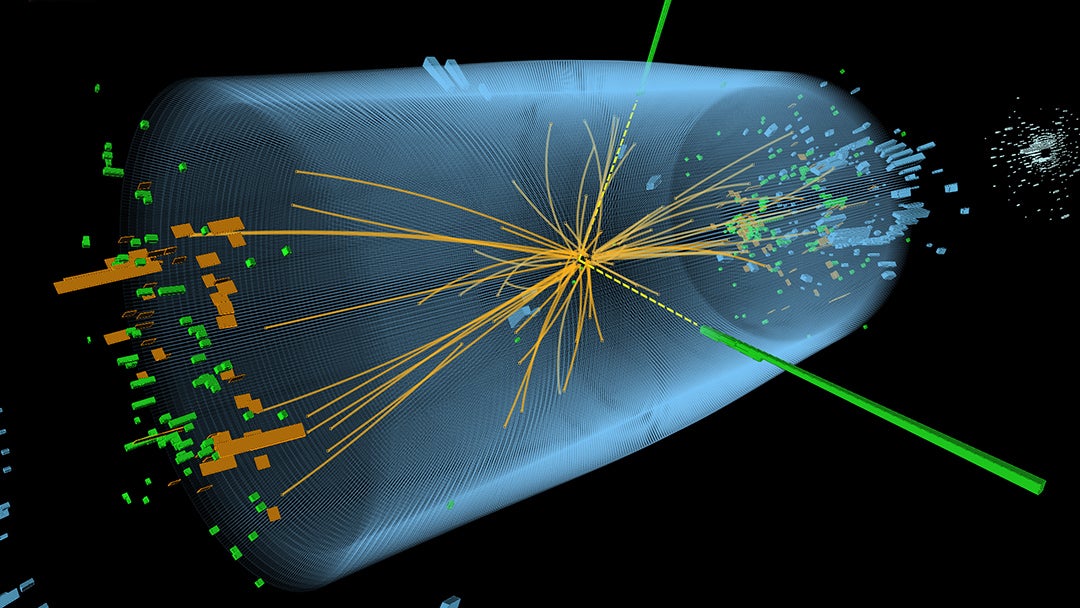
Rice at STAR: From Collisions to Clarity

The same philosophy of building what you need to discover what you don’t yet understand also defines Rice’s work at Brookhaven National Laboratory in New York. While CMS at CERN investigates the origins of particle mass and fundamental forces by colliding protons, the STAR experiment at Brookhaven’s Relativistic Heavy Ion Collider (RHIC) explores the behavior of matter by smashing together heavy ions — nuclei of gold atoms. Through STAR, the longest-running nuclear collider experiment in history, physicists study the universe during the hadronic era, the first few millionths of a second after the Big Bang, when nuclear matter first began to cool and condense.
During this era, protons and neutrons hadn’t yet formed. Instead, their constituent particles — quarks and gluons — moved freely in an ultra-hot, dense state known as quark-gluon plasma. Physicists theorized that if they could recreate the extreme conditions of those first microseconds, structured matter would “melt” back into this primordial form. Professor Frank Geurts, who joined Rice in 2000 and was named co-spokesperson of the STAR collaboration in 2023, has contributed significantly to studying exactly that phase of matter. “The quarks don’t know anymore whether they belong to this or that proton or neutron,” Geurts explained. “They become like this soup of quarks and gluons, and our goal was to create this in the lab by colliding.”
What STAR found surprised everyone. Physicists had expected the plasma to behave like a hot, weakly interacting gas, but instead, what emerged behaved more like a liquid — dense, strongly interacting and nearly frictionless. “It was a paradigm shift,” Geurts said. “What we measured was actually more compatible with not so much a gas, but a liquid … and that was a wonderful breakthrough for the field.”
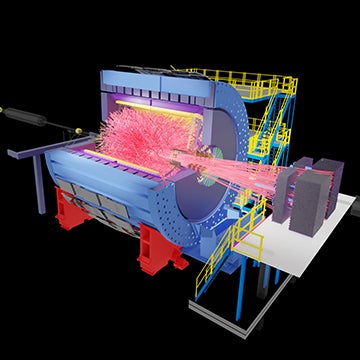
Rice once again played a leading role in developing one of the key detector systems that made this discovery possible: the Time-of-Flight (TOF) detector. The project was led by Rice physicist Geary Eppley, who helped design and prototype the system as one of Rice’s first major contributions to STAR. Installed around the original detector like a sheath, the TOF detector acts like a stopwatch, precisely measuring the time it takes for particles to travel from the collision point to the detector wall with an accuracy of 80 picoseconds. That timing data helps physicists identify exactly what kinds of particles are produced in a given event — an essential step for interpreting the raw data from high-energy collisions. Rice researchers, working with international collaborators, helped pioneer the use of multi-gap resistive plate chambers as a cost-effective technology that made the large-scale TOF detector possible.
At the same time, Rice physicists also designed and built STAR’s Central Trigger Barrel, an early detector subsystem devised to select which collisions were worth recording from among the thousands happening every second — the same problem faced at CMS. As Eppley put it: “The idea of a trigger is to find out which collisions are interesting, so you can pick one in a thousand or one in a million.”
Together, these innovations aided by Rice facilitated a new chapter for STAR. With the TOF system in place, scientists launched the first beam energy scan in 2010, varying the collision energies of the ions to map out how matter behaves under extreme temperatures and densities. “Now that we’ve seen that quark-gluon plasma is a strongly interacting liquid,” Geurts reflected, “we wanted to start exploring the phase diagram of matter.” Like water that can exist as ice, liquid or steam depending on temperature and pressure, nuclear matter too has a phase diagram, but one we’re still trying to map. The TOF detector allowed scientists at RHIC to vary the energy of their collisions and watch what happened as the plasma “turned off,” marking the boundaries of this unfamiliar chart.
What makes the STAR experiment remarkable isn’t just that it recreates a phase of matter from the first five microseconds after the Big Bang, but that it does so thousands of times per second, producing billions of “little Big Bangs” that are recorded and analyzed by scientists worldwide. “We smash things to smithereens,” Geurts said, “and we actually do learn a lot.”

Experiments that Outlive their Builders
Although CMS and STAR study different aspects of the fundamental universe in different ways, they do so with remarkably similar tools. Both the LHC and RHIC are particle colliders, built to accelerate matter to near light-speed and smash it together with extraordinary force. Both have the flexibility to operate as particle physics experiments, colliding protons, or as nuclear experiments, using heavy ions.
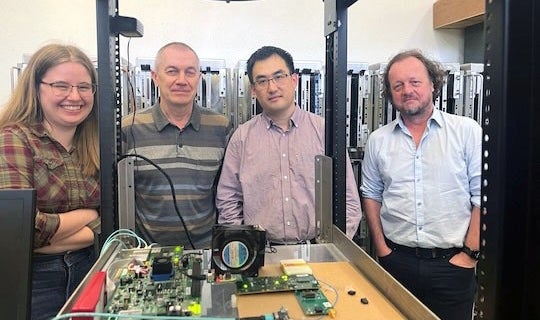
At the LHC, experiments like CMS and ATLAS devote about three weeks each year to heavy-ion collisions of lead, as the LHC offers higher energy capabilities than RHIC. At RHIC, while STAR is best known for its heavy-ion program, it too has conducted major proton-proton studies, contributing to both fields. The distinction between particle and nuclear physics, in the end, is not a matter of technology. A member of the CMS collaboration since 2009, Professor Wei Li has helped lead efforts to adapt the particle physics tools of the LHC to the study of nuclear matter — using the same detector, but with different materials and methodologies. “We share the same detectors, but the physics objectives are different,” he noted.
At Rice, the ability to move relatively fluidly between the two fields is quite unique. Over the years, Rice has built a community where collaboration across fields — and skill sets — is a defining strength. This uncommon consonance between nuclear and particle physics is not accidental, rather a deliberate, long-standing culture that has allowed Rice to punch far above its weight in both fields. “We make very big contributions,” Padley said, “much more than what you would expect for a university group of our size.”
That impact comes from how deeply Rice integrates hardware development and data analysis, and from how faculty across fields work together to build experiments from the ground up. Students are encouraged to expose themselves to every stage of the experiment’s life, from design to data. “Not every group has the opportunity to get involved in a project like this,” Li added. “We’ve always done both the technical work and the physics. That’s somewhat unique to Rice.” For students, that means learning to design experiments as well as analyze their results — an experience that’s rare even at the world’s largest labs.
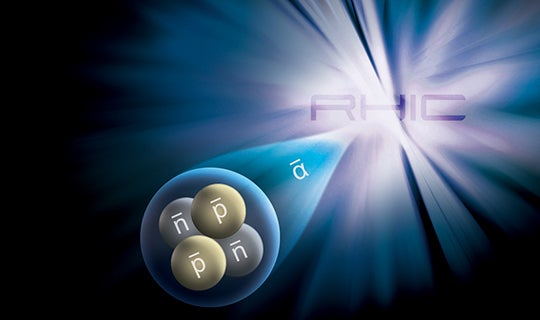
This culture has produced contributions that stretch far beyond Houston. At STAR, Rice students and faculty helped build the detector that made some of the experiment’s most remarkable discoveries possible. In 2011, Rice graduate student Jianhang Zhou identified the first antihelium-4 candidates ever seen — an observation of one of the rarest forms of antimatter, made possible by the tools Rice helped design. “As a student, Jianhang discovered two or three candidates back then,” Geurts recalled. “He had thought they were just outliers that didn’t make sense. But in the end, with that new detector, it does make sense. Science is fantastic.”
At its core, the story is not just one discovery, but of the community that made it possible. Padley described the CMS collaboration as a kind of “peace mission,” bringing together scientists from across the globe to pursue common questions. And for Rice students, being part of that environment is formative. “It’s a wonderful experience for students,” he said. “They learn how to work in big teams, how to communicate, how to handle complex technical work. It’s not just about physics — it’s about how the science gets done.”
Ecklund emphasized that the legacy of experiments like CMS and STAR is not only scientific, but also deeply human. “It truly is a community effort where the whole is greater than the sum of the parts,” he said, “not just for the detectors or data, but for science and humanity.”
Geurts echoed those same values from STAR. For him, one of the most rewarding parts of the experiment has been watching students grow into leadership roles. “It’s really so cool to see that the field is still as vibrant as it was back then,” he said. “You see students develop a passion and carry it forward, whether they stay in academia or not.” As STAR co–spokesperson, Geurts takes pride in representing a collaboration that he described as being at “the very forefront of science” — a community built not just on detectors and papers, but on continuity, curiosity and shared ambition.
In collaborations as large as CMS, with more than 5,000 scientists, or STAR, with over 700, no one person “finds” the Higgs or “discovers” the perfect fluid. Every major result emerges from thousands of small, deliberate contributions: conversations, design choices and shared ideas. “Collaboration can come up with so much more than the individuals,” Geurts said. “This idea that somebody in a room comes up with a brilliant idea and that’s how science moves forward is wrong. It’s all about people working together.”
Rice’s contribution was never just about the experiments themselves, but rather contributing to the culture of science and human progress as a whole. It’s about the people, and the way they are taught to believe that discovery is something built together, across time, cultures, fields and generations.
The New Era
At most institutions, nuclear and particle physics operate in separate orbits. But at Rice, they operate in tandem — researchers from both groups contribute to shared projects, lead in international collaborations and co-mentor students who work between the two disciplines. As Acosta, who joined Rice in 2021, said, “One of the attractions for me to come to Rice was its leading reputation in both the particle and nuclear fields and the synergies that stem from that.”
That kind of ambition shows in the science itself. CMS was critical in confirming the existence of the Higgs boson and measuring its properties; STAR proved that quark-gluon plasma wasn’t a gas but a strongly interacting liquid. Both discoveries, as Geurts said, have reshaped the way physicists think about the very fundamentals of reality.

Rice’s role in these breakthroughs has been real and lasting — and now we’re helping lead what comes next. Geurts is guiding STAR through its final run, which will supply enough data for analysis to stretch into the next few years. Rice physicists working at CMS are preparing for an upgrade called the High-Luminosity LHC (HL-LHC), an even more powerful collider than before. HL-LHC’s Endcap Timing Layer, which will help distinguish particles with unprecedented precision, is being led by Li. Since 2015, Ecklund has led the U.S. effort for the upgrade of the pixel detector and also serves as the CMS coordinator for the Inner Tracker upgrade. Acosta and Padley are also leading critical upgrades to the muon trigger and muon system. This project reflects Rice’s deep involvement not just in analysis, but in designing and building the very tools of discovery.
Remarkably, the students trained at Rice — students who once inherited these projects — are now driving them forward and mentoring the next generation. “To see ideas form in conversation,” Geurts reflected, “that’s the most rewarding thing.” That emergent process — the same one that STAR uses to study heavy-ion collisions, where matter becomes more than the sum of its parts — is alive in the collaborations themselves. People come from across the globe to learn and build together, united by curiosity and a collective goal of advancing science further than it could have gone alone.
There’s a quiet irony in it all: that by tearing matter apart, we’re also building up a legacy — of knowledge, of people and of purpose. Just as the universe preserves its earliest moments in traces left behind, at Rice, those traces are people — students who become researchers, researchers who become mentors, and a legacy that is still unfolding, one person at a time.
— Magdalena Whelley ’27
This work was made possible with support from the Fondren Fellows program.
